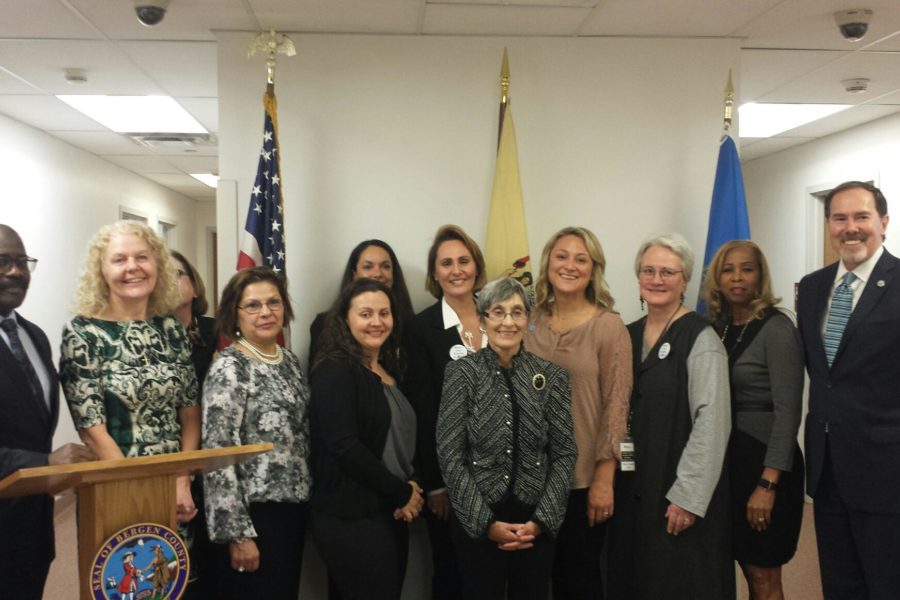Julia Orlando is not interested in your excuses.
Talking on speaker phone from her office at the Bergen County Housing, Health and Human Services Center, she walks me through the work she and her team have undertaken over the last several years to tackle homelessness locally, first among veterans and more recently among those experiencing chronic— or long-term— homelessness.
Increased coordination: check. A countywide commitment to Housing First: check. Clear monthly performance targets: check. Real-time, person-specific data: check.
“When we first started working with Community Solutions,” Orlando says, “I used to tape monthly housing targets on the outside of my door and tell my team, ‘We’re a few move-ins shy of our goal this month. Which one of you is going to figure that out?'”
This week, that willingess to hold herself and her team accountable paid off when HUD, USICH and Community Solutions all confirmed that Bergen County— a county of roughly a million people— had become the first community in America to measurably and sustainably end chronic homelessness.
“Bergen County didn’t end chronic homelessness by having more money or better knowledge than other communities,” says Beth Sandor, Director of Community Solutions’ Built for Zero campaign. “They built a better, more coordinated housing system— a command center.”

Community Solutions has worked with Bergen County since 2011, when the county joined our 100,000 Homes Campaign. As a star performer, Bergen routinely exceeded its monthly housing targets. Today, as part of our Built for Zero campaign, it continues to be a source of ideas and innovation to many of its peer communities.
Orlando says the County’s success comes down to four things:
First, the County created a one-stop model designed to increase collaboration across its multiple housing and service providers. Most communities have more than one group working to respond to homelessness, but often, these groups work in isolation or at cross purposes. Bergen moved many of them into the same building, which also served as an overnight low-barrier shelter for guests.
Orlando, a trained disaster response professional, likens the model to a command center and says, once they co-located, it was easier for multiple agencies to work together around the same people in need of housing. Groups committed to assess people using the same coordinated assessment tool and prioritize resources according to a shared set of criteria. Bergen’s public housing authority came to the table as well, committing to allocate 20% of its housing vouchers to people experiencing homelessness as they became available.
Second, Bergen made a countywide commitment to Housing First, the evidence-backed philosophy that dictates people move into permanent housing as a first step, not a last step, in the housing process. Today, a collaborative network of local agencies connect people to permanent housing as quickly as possible and then continue to work with them on other challenges, like employment or mental health treatment.
“Delivering excellent services in housing is a huge focus for us,” says Orlando, who notes that a full 95 percent of those housed in the County never return to homelessness. Even when people do fall out of housing, Orlando, her team and their many partners work rapidly to rehouse them.
The third ingredient in Bergen County’s recipe is the use of data to target available housing resources. The BCHHHC, where Orlando works, serves as a single point of entry for housing, although no individual needs to be in shelter to obtain housing. The County’s coordinated assessment criteria dictate that people experiencing chronic homelessness are prioritized for permanent supportive housing— a long-term rental voucher connected to ongoing supportive services— while those with lesser needs are connected to effective, lower cost options. The effect of the County’s coordinated assessment process has been to remove any shortcuts or secret side doors for its limited resources—everyone plays by the same set of rules. Members of the local Continuum of Care have worked to ensure collaboration both inside and outside the walls of the BCHHHC in a philosophy local partners call “housing without borders”.
Finally, Orlando gets around to the big one: every good command center needs real-time, person-specific data.
“Before we started working with Community Solutions, we weren’t setting monthly housing targets, and while we knew many of the people experiencing homelessness, we weren’t collaborating to house them as effectively as we do now,” she says.
Today, Orlando’s team can rattle off the names of people experiencing homelessness, which means they can develop response strategies and shift resources around in real time. This real-time data is also key to Bergen’s strategy for sustaining its success. While the BCHHHC team has always used data to identify needs and trends on an individual basis, local partners have worked with Community Solutions to learn how to turn the entire Continuum of Care into a data-gatherer, creating what Orlando calls “a much bigger web for the spider.”
“I recently had a team member tell me that a person we’d been tracking was going to meet the criteria for chronic homelessness in a month,” says Orlando. “I said, ‘We’re at zero. Now you’re telling me we’re going to let someone age into chronic homelessness? That’s embarrassing.”
They didn’t. The team put their heads together and the individual was in permanent housing within a few weeks.
“Now that we’re here, we’re not going back,” Orlando says.
To be certified as having ended chronic homelessness, Bergen County had to prove it had reduced chronic homelessness to fewer than 3 people, or .1% of its most recent annual homeless census. (As it happens, the County has achieved a hard zero.) When that bar was first set, many communities complained that it was unreachable.
Asked what she would say to those communities, Orlando is clear:
“You can do it,” she says. “We’re proof that anyone can get here.”




